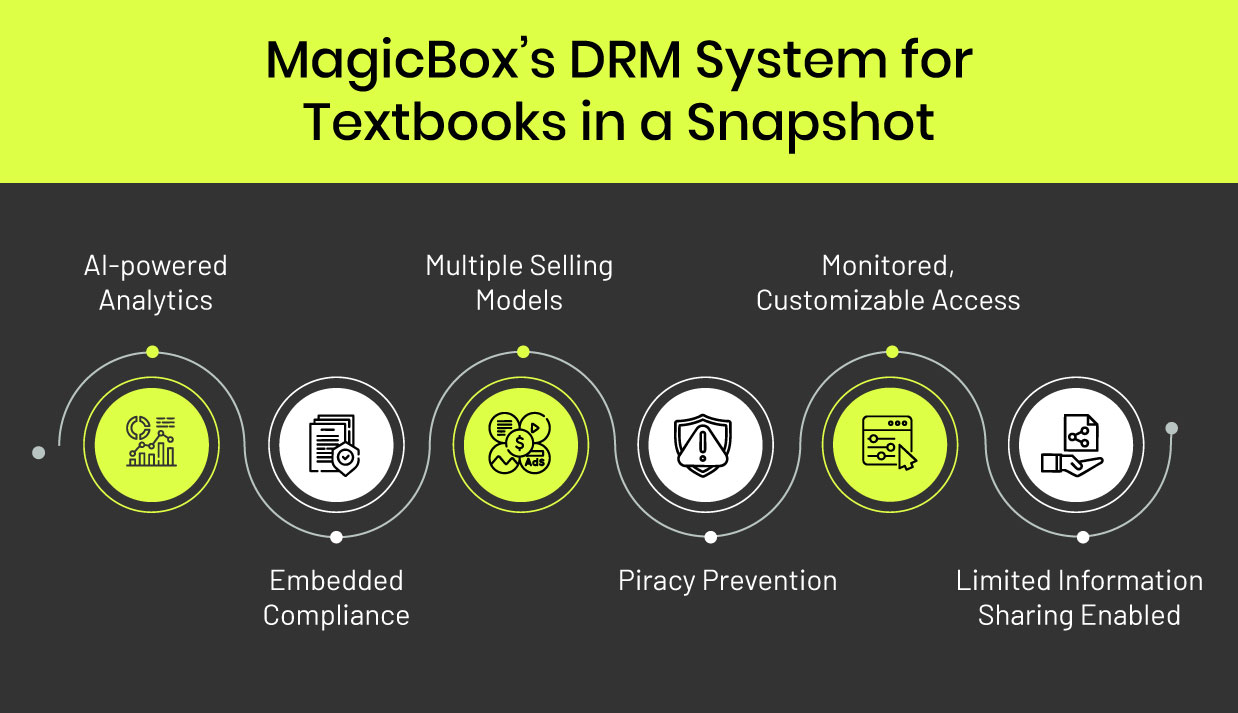
DRM for Textbooks: The Cornerstone of a Sustainable Digital Publishing Strategy
As learning expanded out of classrooms, K–12 publishing embraced the digitization of education by transitioning content from print to digital. To offer exceptional experiences, K-12 publishers began incorporating interactive elements, accessibility enhancements, and seamless LMS integrations to meet the evolving demands of the industry. Unfortunately, in their pursuit of delivering enriched learning experiences, publishers often overlook security. Without a strong digital rights and distribution strategy, you could end up losing revenue. This is because digital publishing was the only sector in which piracy grew in 2024. Visits to websites serving pirated content surged to 66.4 billion, making publication piracy the second-largest target category after TV. This is why DRM for textbooks is critical for K-12 publishers.
Integrating DRM across your publishing and distribution workflows lays the foundation of long-term, sustainable success in the digital learning ecosystem. It blocks revenue leakage while maintaining client trust.
Redefining DRM: From Defense to Strategic Enabler
The problem is that DRM has a reputation of being a restrictive force, a ”lock” that downgrades user experience. Let’s bust this myth once and for all. DRM is actually a strategic partner for textbook publishers. It enables effortless licensing, user control, and flexible access while securing your distribution pipeline.
Publishers get to serve students, teachers, and educational institutions better while preserving content integrity. With a strong DRM solution, you can offer access tailored to user roles, geographies and institutional needs. DRM for textbooks gives a sense of being “watched,” which encourages responsible use.
More importantly, advanced DRM solutions drive precision in access, analytics, and integration. It helps publishers align access with learning models. You can also track usage patterns and leverage the insights for decision-making. Moreover, DRM allows K-12 eBooks to seamlessly integrate with LMSs, SISs, and other classroom tools while securing distribution.
Deliver Equitable Access at Scale
Equitable access has grown into a key focus for K-12 education. Digital rights management allows K-12 publishers to control when, where, and how their digital textbooks are accessed. DRM features, such as timed access, role-based access, and offline availability, make sure that the textbooks are accessed by authorized users.
Monetize Without Impacting Security
Security is often a trade-off against revenue opportunities. Advanced DRM systems for textbooks power publishers to adopt flexible business models, such as subscriptions, rentals, volume licensing, etc. This ensures monetization without compromise. Plus, controlled, license-based access reduces revenue loss from unauthorized sharing, redistribution, or duplication. Robust digital rights management helps K-12 publishers build trust with institutional buyers via secure digital textbook distribution and compliant learning solutions.
Future-Proofing Your Publishing Strategy
Did you know that the December 2024 security breach of PowerSchool, a US-based edtech platform, put the PII and SSN of nearly 60 million students at risk? As learning goes increasingly online, digital rights management will become even more critical for K-12 publishers.
Compliance-ready DRM frameworks can help publishers cater to data privacy laws, such as FERPA and COPPA, as well as interoperability standards, such as QTI, LTI and TinCan. Additionally, continued monitoring provides valuable insights into content usage to help refine content and drive AI-powered personalization.
In an anytime-anywhere ecosystem, learning takes place through multiple devices, diverse collaboration tools and platforms, across geographies. DRM-backed digital textbook protection ensures content consistency and security across contexts. Future-ready DRM is imperative for educational publishers to stay competitive in the overcrowded K-12 learning space.
Read more related article: https://www.getmagicbox.com/blog/protecting-your-content-5-digital-rights-management-strategies-for-educational-publishers/
DRM Is Not a Roadblock—It’s the Roadmap
It is time to discard the perception that DRM is a roadblock for textbook publishing. In digital learning systems, eBook DRM is foundational to protecting and growing your K-12 digital publishing business. DRM for digital textbooks balances secure content delivery and effortless, equitable access for K-12 and higher education learners. Now is the time to act if you want to stay competitive, compliant, and sustainable. Invest in intelligent DRM frameworks to protect your textbooks while adding value to your monetization pipelines.
The most effective course of action for this is to partner with a multi-award-winning industry leader for your DRM needs. MagicBox’s DRM for textbooks enables no-code integration for K-12 publishers. It is a robust and cost-effective solution to ensure secure content delivery via features such as:
- Prevention of screengrabbing, printing, or copying of digital content.
- Time and role-bound access automatically revoked, if not renewed on expiry.
- Restrictions on the number of devices with which a user can access the content.
- Separate student and teacher access codes for eBooks and other learning resources.


MagicBox’s DRM solution also supports a variety of sales models, including bulk B2B selling and short-term access. Plus, it protects interactive, multimedia content as effectively as status PDFs. Speak to the experts to get the Magic touch and safeguard your K-12 textbook publishing with a powerful DRM system.
Source link




